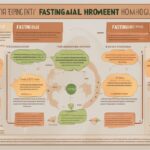Are you searching for a sustainable way to improve your health, shed some extra pounds, or boost your energy levels? If so, Alternate Day fasting (ADF) might just be the game-changer you’ve been looking for. Often referred to as an ADF schedule, this fasting method alternates between days of normal eating and days of significant calorie restriction. It’s not just a diet trend—it’s a lifestyle shift backed by science. In this comprehensive guide, we’ll dive into what an ADF schedule entails, how it works, its benefits, and practical tips to make it work for you. Whether you’re a fasting newbie or a seasoned pro, let’s explore how this unique approach can transform your wellness journey.
What Is an ADF Schedule and How Does It Work?
Alternate Day Fasting, or ADF, is a type of intermittent fasting where you alternate between “feast days” and “fast days.” On feast days, you eat normally—consuming your usual calorie intake without restrictions. On fast days, you drastically reduce your calorie intake, typically to about 500–600 calories, or in some cases, consume nothing at all. This ADF schedule creates a cycle that can help your body tap into fat stores for energy while giving your digestive system a break. Unlike other fasting methods like the 16/8 plan, ADF focuses on full-day cycles rather than daily eating windows, making it a distinct approach to intermittent fasting.
The Science Behind Alternate Day Fasting
There’s more to an ADF schedule than just cutting calories. Research shows that ADF can trigger several physiological changes in the body. Studies published in journals like Obesity and The American Journal of Clinical Nutrition have found that ADF can lead to significant weight loss, improved insulin sensitivity, and reduced inflammation markers. When you fast, your body enters a state called ketosis, where it burns fat for fuel instead of glucose. Additionally, fasting on alternate days may promote autophagy—a cellular “cleanup” process that removes damaged cells and supports longevity. These benefits make an ADF plan a compelling choice for those looking to optimize their health.
Key Benefits of Following an ADF Schedule
Why should you consider adopting an ADF schedule? The benefits go beyond just weight loss. Here are some of the standout advantages that have made ADF a popular fasting method:
- Weight Loss: By creating a calorie deficit over time, ADF helps you shed excess pounds without constant restriction.
- Improved Metabolic Health: ADF can lower blood sugar levels and improve insulin resistance, reducing the risk of type 2 diabetes.
- Heart Health: Studies suggest ADF may decrease LDL cholesterol and blood pressure, supporting cardiovascular wellness.
- Mental Clarity: Many followers report enhanced focus and energy on fasting days due to stabilized blood sugar levels.
- Simplicity: Unlike complex diets, an ADF fasting plan is straightforward—eat one day, restrict the next.
Potential Challenges of an ADF Schedule and How to Overcome Them
While an ADF schedule offers impressive benefits, it’s not without its hurdles. Hunger pangs, irritability, and fatigue are common, especially when you’re new to fasting. Some people also struggle with overeating on feast days, which can offset the calorie deficit. The key is preparation and mindset. Start by easing into your ADF routine—perhaps begin with a modified fasting day of 800 calories before dropping to 500. Stay hydrated with water or herbal teas on fast days to curb hunger. Additionally, plan balanced meals on feast days to avoid bingeing. With time, your body will adapt to the ADF fasting schedule, and these challenges will lessen.
Practical Tips for Building a Sustainable ADF Routine
Ready to start your ADF schedule? Success with Alternate Day Fasting comes down to strategy. Here are actionable tips to help you create a sustainable ADF plan that fits your lifestyle:
- Choose Nutrient-Dense Foods: On fast days, opt for low-calorie, high-volume foods like vegetables, broths, and lean proteins to stay full.
- Time Your Fast Days: Schedule fasting days on less active days to conserve energy and minimize discomfort.
- Track Your Progress: Use a journal or app to monitor your ADF routine, noting energy levels, hunger, and weight changes.
- Stay Busy: Keep your mind off food on fast days by engaging in hobbies, work, or light exercise like walking.
Who Should Try an ADF Schedule—and Who Shouldn’t?
While an ADF schedule can be transformative, it’s not for everyone. ADF is generally safe for healthy adults looking to lose weight or improve metabolic markers. However, it’s crucial to consult a healthcare provider before starting, especially if you have underlying conditions. Pregnant or breastfeeding individuals, those with eating disorders, or people with diabetes on certain medications should avoid ADF due to risks like low blood sugar or nutrient deficiencies. Always prioritize safety when exploring an ADF fasting plan, and tailor it to your unique health needs with professional guidance.
In conclusion, adopting an ADF schedule through Alternate Day Fasting offers a powerful, science-backed way to enhance your health, lose weight, and simplify your eating habits. By alternating between feast and fast days, you can tap into benefits like improved metabolism, heart health, and mental clarity. While challenges like hunger may arise, practical strategies and a gradual approach can make your ADF journey sustainable. Remember, consistency is key—start small, listen to your body, and consult a professional if needed. Ready to give an ADF fasting schedule a try? Take the first step today and discover how this unique fasting method can work for you!






